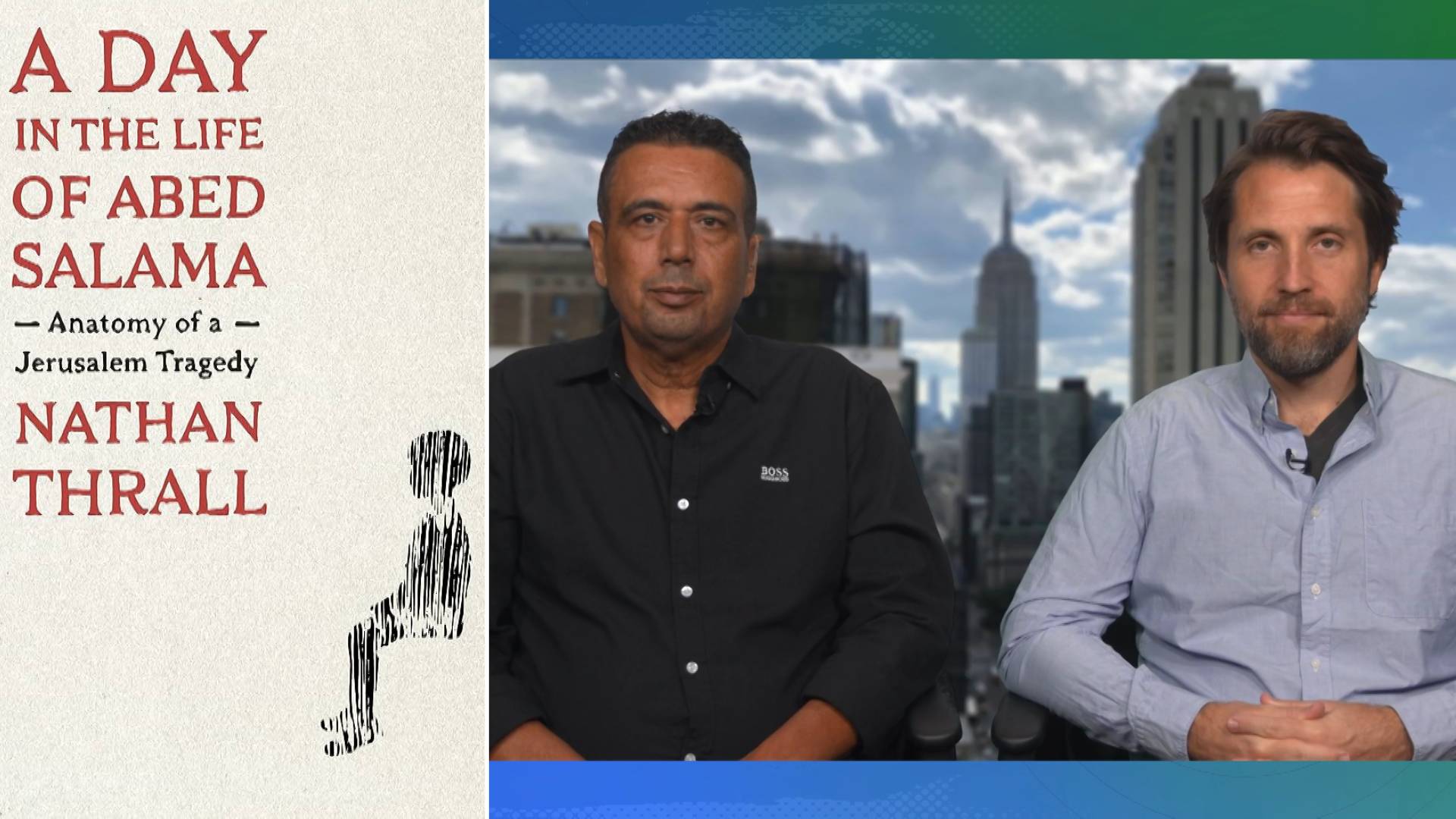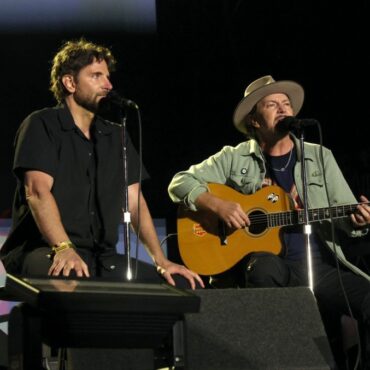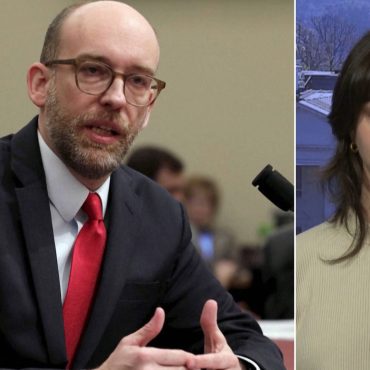This is a rush transcript. Copy may not be in its final form.
AMY GOODMAN: This is Democracy Now!, democracynow.org, The War and Peace Report. I’m Amy Goodman.
In this holiday special, we spend the rest of the hour speaking with Nathan Thrall and Abed Salama. Democracy Now!‘s Juan González and I spoke to them in early October, just after the publication of Nathan’s remarkable book, A Day in the Life of Abed Salama: Anatomy of a Jerusalem Tragedy. The book looks at the devastating reality for Palestinians living under Israeli occupation, through the lens of a Palestinian father.
Abed Salama lives in Anata, a segregated Palestinian neighborhood on the outskirts of Jerusalem that’s surrounded on three sides by the 26-foot-high Israeli separation wall — many refer to it as the “apartheid wall.” In February of 2012, tragedy struck Abed’s family. His 5-year-old son Milad died in a fiery bus crash during a school field trip to a theme park. Abed’s quest to find out what happened to his son was immediately hindered because he was a Palestinian living on the wrong side of the separation wall. He held the wrong ID to pass Israeli military checkpoints and didn’t have the right papers to enter the city of Jerusalem.
Nathan Thrall, who lives in Jerusalem, wrote about this tragedy in a remarkable 2021 essay for The New York Review of Books.
Juan González and I spoke to Abed Salama and Nathan Thrall and aired the interview on October 5th. That was two days before Hamas’s October 7th attack on southern Israel and the start of Israel’s assault on Gaza. Nathan began by discussing why he wrote about Abed Salama and the tragedy of his family.
NATHAN THRALL: You know, this event is every parent’s worst nightmare and an awful, awful tragedy under any circumstances, but it was made so much worse by the unique circumstances in which it took place, by the fact that the victims were Palestinian, that it took place on a road that is controlled by Israel, patrolled by Israeli police, but on the other side of a separation wall, a 26-foot-high concrete wall that separates and segregates tens of thousands of Palestinians from Jerusalem, born and raised in Jerusalem, residents of the same city I live in, but who are cut off from the city that they were born and raised in specifically because of their ethnic identity. And these people live in the same city as me, but they live an entirely different existence.
And the parents of the kids on this bus live in a walled ghetto, encircled on three sides by this separation wall, and a fourth side by a different wall that runs in the middle of a segregated road, famously called “the apartheid road.” And inside that walled ghetto, which sits just underneath the manicured grounds of Israel’s most prestigious university — you can look down on it, from Hebrew University down onto this ghetto, with trash being burned in the street because the municipal services are nonexistent there, with no sidewalks, roads in total disrepair. When I drive into this area to visit Abed and other families there, I have to pull off to the side just to let a bus pass on the main artery for tens of thousands of people. I’m rolling down my window and pulling in my side mirror to let a regular bus pass me. And this is just the everyday reality of all of these people. They receive virtually no services from the city that they pay taxes to.
And they are forced to prove that they have maintained their residency in the right part of this enclave, or else Israel will strip them of their blue ID, which allows them to travel in and out of Jerusalem. And they live in terror of having this blue ID taken away from them. Some of the parents in this area have green IDs; some have blue. They’re all from the same families.
And the outcome for them on this day was very different. There were real consequences to having a different-colored permit on that day. Abed was one of the parents who wasn’t able to go and look for his kid in Jerusalem, when he was told that that’s where his boy was. And other other parents did. There were bystanders. Because the emergency services came so very late, all of the kids had been evacuated by just ordinary people in private cars, before the first Israeli emergency service provider arrived. And those people themselves drove off in all kinds of different directions depending on what kind of color ID they had and whether they could pass through a checkpoint. And there was total chaos. Parents didn’t know where their own children were. And so, this awful event allowed me, in telling the story, to describe the entire elaborate system of segregation and subjugation and apartheid in which all of these people live.
AMY GOODMAN: Abed, I hate to take you back to that day, but it is such an important story for people to understand. Introduce us to your little boy Milad, and talk about what happened that day.
ABED SALAMA: Hi, everyone.
My son Milad, he was only 5 years old. He was a cute boy, a cute boy, a funny boy, a lovely life.
So, the day before the accident, in the night, he said, “Father, I want to buy some sweets and chocolates for my trip.” It is the first trip with the school. So I took him to a grocery around, supermarket, and he buy his things and the favorite chocolate, the Kinder Kids, and juice. Then we go back home. He was very excited to join his friends on the journey and the trip. So, we got to sleep earlier.
Next day, I was planning to go to Jericho for business with my cousin. There was — early in the morning was very stormy. So, I got up. I didn’t see Milad when his mother prepared him and put him in the bus to — in the car to the school. So, after an hour, my cousin came, and we took his car on our way to Jericho. Then I received a phone call from my nephew. He asked me if Milad in the bus with the school, in the bus to the trip. I said — I told him, “Yes, he is there.” He said, “Uncle, there’s an accident in Jaba road. A bus has crashed.” So, we went — we changed our way from Jericho to Jaba road in that stormy weather.
When we arrived before the accident, or the place of the accident, before, there is a military — Israeli military checkpoint. They closed the street before. They didn’t allow to us to pass with a car. So I jumped out of the car and start turning to the place of the — to the accident. In my way — you know, it’s raining and stormy weather — a military Jeep passed me. So I start to — I wanted to stop them to take me with them. They didn’t take me, so I continued my way to the place of the accident, running uphill.
So, when I received there, there was nothing. Only I saw the bus crashed on the side and a big trailer on the other side of the street. So I start asking about what happened to the kids. “Where are the kids?” Everyone — there was many, many people around. There was only one fire truck. I didn’t see any ambulances at the time. I saw only civilian police officer from the PA. So, the main thing at that time, I wanted to know what happened to the kids, where are they, and start searching and asking, “Where are they? Where’s the kids?” So, somebody told me that they took them to — some of them took to Hadassah Ein Kerem Hospital in East Jerusalem. Others told me they took them to a military space, Israeli military space around. And others told me maybe they took them to the hospital in Ramallah. So, I asked — I met two guys from Jenin, I thought. I asked them to take me to Ramallah Hospital. I didn’t — they are strangers; I didn’t know them. They are allowed to take me. Then they took me to the hospital.
When I arrived there, it was very crowded, many, many people there, the parents of the victims and the police and the ambulances, media. It was very, very crowded. And I start to search in the building of the hospital. So I asked the doctor who was in the reception about what — “I’m looking for my son Milad. He was in the accident.” When she looked at the list, she didn’t find his name. She told me his name is not in the list of the — on this bus. So I started to search in the hospital rooms. I didn’t meet — I didn’t find them. I met other parents who are from our neighborhood I know, and they find — already find their kids. They were injured. And I asked them if they saw my son or their sons know anything about Milad. Everybody was busy in his own case. So everybody said, “No, we didn’t find him.”
So, here, I started my — I started to search where to search. I searched again the same hospital. I didn’t find him. Then somebody told me, “Maybe they took him to Hadassah Ein Kerem Hospital in East Jerusalem.” I didn’t have a permit to pass the checkpoints to Jerusalem. They didn’t allow to us to pass, because I have a green ID, Palestinian ID. So I called a cousin of mine who have blue ID, and asked him to search in Hadassah Ein Kerem. After maybe one hour or two hours, he called me back. He said, “I searched all the hospital there. Milad is not there.” So, after six or seven hours, everyone from the parents find his son injured or safe, except me and seven other, six families.
So, a doctor from there came to me, and he said, “You didn’t find your son yet. And we have to take some blood from you to make a DNA test.” I asked him why. He said, “We have six bodies for small children and the body of the teacher, burned.” So he asked me also to call my wife and my son Adam to come to the hospital to take blood from them for the test, DNA test. I called them. It took more than an hour to receive to the hospital. So, they took blood from us. My wife was shocked. I was crying. At the same time, I was looking at her face and my Adam’s — son — face. They were shocked. She did cry until now. I think she’s still in shock.
AMY GOODMAN: That was Abed Salama describing the death of his 5-year-old son Milad in a fiery bus crash on the way to a theme park in Jerusalem in 2012. We’ll return to our interview with Abed and journalist Nathan Thrall, who just won the Pulitzer Prize for his book, A Day in the Life of Abed Salama: Anatomy of a Jerusalem Tragedy. This interview aired on October 5th, two days before the Hamas attack on October 7th. Back in a minute.
[break]
AMY GOODMAN: This is Democracy Now!, democracynow.org, The War and Peace Report. I’m Amy Goodman.
We continue our conversation from last October with Abed Salama, a Palestinian father whose 5-year-old son Milad died in a fiery bus crash in 2012 in Jerusalem. The journalist Nathan Thrall writes about them in his book, A Day in the Life of Abed Salama: Anatomy of a Jerusalem Tragedy, which just won the Pulitzer Prize. Democracy Now!’s Juan González and I spoke to Abed and Nathan. Our interview aired on October 5th.
AMY GOODMAN: Nathan Thrall, you write about that dangerous road that Milad would die on. You said, “Everyone knew how quickly Israeli forces would descend on a West Bank road the moment a [Palestinian] kid started throwing stones [at Israeli soldiers or settlers]. Yet the soldiers at the checkpoints, the troops at Rama base, the fire trucks at the settlements nearby, they had all done nothing, letting the bus burn for more than half an hour.” If you can talk about this, this architecture of separation, of apartheid, that led to the beginning, so that what we hear in Abed’s story is not just an unfortunate bus crash, but so much of which could have been prevented?
NATHAN THRALL: Yeah. You know, the particular series of events that unfolded that day were entirely predictable because of the system of segregation and neglect that exists in this area. And there had been people who had warned of it. There had been previous incidents where tragedy had struck on the other side of this wall, and Israeli services were greatly delayed or even prevented from coming to the area.
And so, you know, what the book is showing is not — you know, the passage that you mentioned, those were the words of a man who was screaming at Israeli soldiers that morning, after he had almost single-handedly rescued dozens of children. He entered a burning bus repeatedly and pulled kids out of this bus and saved dozens of them. And he was in a state of shock at the end of this. And he was screaming at every person, but particularly at the Israelis, but also the Palestinian emergency service providers at the scene. And he said those words to an Israeli, an Israeli soldier, and he was then summarily beaten for saying what he said, and spent several days in the hospital afterward.
But the point is not that the Israelis who were at the checkpoint just next to the accident didn’t come, or at the military base and took — just next to the accident, and took forever to come. The point isn’t that anybody made a deliberate choice to observe a burning bus of kindergarteners and do nothing. It’s that this entire system was set up to ensure that there would be a very delayed response, that these people live in utter neglect, and nobody cares about them.
AMY GOODMAN: You also write in the book about the small scorched backpacks on the road after the accident. If you can talk more about the effect of this system on children, which is the power of this? And let me ask: Is really your decision to use this example, this bus crash, the horror of the deaths of the children who died in this fiery crash, to show us what’s happening in Palestine and Israel?
NATHAN THRALL: Yeah, it was a very deliberate choice to choose an incident that, although horrific, you know, is an incident that takes place, the kind of thing that takes place all over the world, is a terrible car accident or a terrible bus crash, and to show what it means for this seemingly ordinary event to take place in this particular place under this system, because the point is that the system itself, the policies that are in place, the wall that encircles these communities, the desire to demographically engineer Jerusalem so that it would have the maximum number of Jews and the minimum number of Palestinians and to keep for Israel the maximum amount of land, and the entire route of this wall, the way that it snakes around this community and encircles it and traps it in this ghetto, all of that is dictated by this racist logic. And I didn’t want to choose to tell a story that would be exceptionalized and that we would look at some particular act of violence and ask about the, you know, perpetrators and the victims and why this event took place on this day. I wanted to show the system that is crushing people every day. And it’s brought into sharp relief on the worst day of these people’s lives, but they are suffering all of these obstacles and all of this pain from this system, day in and day out.
JUAN GONZÁLEZ: Nathan, you also describe in your book not only the total disregard and neglect of the Israeli services to the victims of the accident, you also talk about, a week later, a left-wing television reporter, Israeli television reporter, did a story not so much about the accident itself, but how shocked he was at the reaction of residents, of Israeli residents around the area, to the accident.
NATHAN THRALL: That’s right. Several weeks after the accident, an Israeli journalist, a TV journalist, decided to create a feature about something that had shocked him to his core, which was that many, many Israelis on the day of the accident, young ones in particular, were writing how happy they were that these children had died. And they were — what shocked the journalist — his name is Arik Weiss — what shocked him the most was that people did it without hiding their identity. They felt so comfortable writing racist posts and celebrating the death of innocent 5-year-olds, without masking their true names. And so, he decided to write — to create a feature, a TV feature, about these kids who wrote the posts. Some of them — most of them were kids, I think. And really what his aim was, was to, as he says, to show a mirror to his own society and to ask, “How did we get to a point where so many young people feel that this is acceptable and aren’t afraid even of being caught expressing these views?”
And they go on. He finds many of the people who posted on that day, and they go on to proudly reiterate the kinds of things that they had written that morning. And, you know, the accident was now just over 10 years ago, and we see that the trends that this reporter was highlighting have only gotten worse. And we see, you know, senior ministers in the Israeli government who are openly racist. And, you know, when you poll young Israelis, you see they have extremely right-wing views and racist views. So, it was a prescient report that he made.
AMY GOODMAN: Abed Salama, what has been the response in your community, in your family, to Nathan focusing on this tragedy and the loss of Milad in his book, A Day in the Life of Abed Salama?
ABED SALAMA: In the beginning, my family refused, and especially my wife, she refused to talk about — until now, she refused to talk about the accident and to talk about Milad, our son, until now. So I took this responsibility alone.
And I decided to share our tragedy with Nathan maybe for two reasons. The first one is because I love all the time to talk about my son, when I talk, when I remember him and I start to speak about him, about what he was doing, about his laughing, his playing, his drawing. So, I love that, because this — this is the main reason.
The second reason, Nathan told me, “I will make, from your case — from this accident, I will write an article” — in the beginning, he write it as an article, not a book — “and this will help your community, Palestinian community. This article will help them to show the Americans and the people around the world how is the Israeli government treat you as Palestinians.” So, when he write the article and I read it and receive many important comments from around the world that it’s a very strong article, he said, “Abed, I want to make it as a book, if you didn’t mind.” Of course I didn’t mind, from the beginning. As I told you, I want to spend many times with a person like Nathan talking about my son. When I start to talk about him, I feel that his spirit is behind me, around me. And this time, I feel Milad sitting with us here. So I love that.
I think and I hope the book will make some changes and help us as Palestinians to live our lives as other people around the world. This is what I hope to. Everyone, every father, every who’s responsible on his family, he wanted only to live in peace and to grow up his children in peace and safe. And as Palestinians, we miss these things. And when you go out from your house, you or your son go out from his house, you didn’t expect him to come back safe, or this is what happened. Because of that, I am happy to share my story with Nathan.
I’m here in New York or in America. This is my first time here. So, as all life here is different, I can see the people here running and playing, walking, enjoying, and the kids also, people here taking their dogs around in parks. We miss these things. I want to tell you something: I have a dog, a pit bull dog in my house. I put him in the roof. You know, the pit bull is a strong dog. So I’m afraid to take him down to walk with him in the street, because the street is crowded, and it’s many, many people. We lived in — 130,000 people lived in a small square, like many. As Nathan told you, it’s a small place for 130,000 people live there. I can’t walk with my dog in the street. I’m afraid to attack somebody or somebody here or there. When I saw the people here in America walking with their dogs and playing with their kids outside in the park, actually, honestly, I feel jealousy. I want this life for my children, for my grandchildren also. I hope if anyone from the American government hear me, I hope I — if you want — we want only justice. This is what we want as the Palestinians in the Palestinian Authority.
AMY GOODMAN: And, Nathan, let me ask you — you first wrote this essay in 2021, that appeared in The New York Review of Books, headlined “A Day in the Life of Abed Salama: One man’s quest to find his son lays bare the reality of Palestinian life under Israeli rule.” The article was 50 pages. It, in itself, was a book. And then you expanded it to the book, the main title the same, A Day in the Life of Abed Salama. What did you learn as you expanded this investigation? And we’ve turned to you for analysis in Jerusalem, what’s happening there. What surprised you most and what affected you most as you went on this journey with Abed?
NATHAN THRALL: The book shares just a page or so of text with the article, despite sharing the same title. And the aim of the book is entirely different than the article. The aim of the book is to immerse people viscerally in the lives of Palestinians living on the other side of this wall and to make them feel and understand what that life is like. And one of the things that struck me more than anything as I was working on it was how much pain there is just beneath the surface in every single Palestinian family. And the book has Abed’s name in the title, but it tells the story of many different characters whose lives collided on this day. And, you know, one of the themes of the book is the degree to which this oppressive system touches the most intimate decisions in people’s lives.
I tell a story of Abed’s early romance and his first marriage. And at one point, he has a job that takes him into the the center of Jerusalem, and he is afraid of losing his access to the city because of his green-colored ID. And he and many other people at that time went and sought out wives who had blue IDs or Israeli citizenship. They were choosing marriage partners in order to keep their freedom of movement in order to keep their jobs. This is the degree to which this huge oppressive system affects ordinary people.
I tell the story of a woman, a doctor named Huda Dahbour, who happened to be on her way to treat Bedouin. She worked for the U.N. Agency for Palestinian Refugees. And she was on her way with her medical team to go and treat a group of Bedouin not too far from the site of the accident, and she stumbled on this horrific site. And she pulled over with her team and helped to rescue children from the bus. And I tell part of Huda’s story. And, you know, Huda had a boy, a teenage boy, who, quite naturally, threw stones at occupying forces in his town outside his school who were harassing him and other students every day. And at 1:30 in the morning, Israeli Jeeps show up and bang on her door and say to Huda, “We’re here for your son, Hadi.” And she can do absolutely nothing. She stands there with tears running down her face, realizing that the jaws of this state are going to come and snatch her boy and take him away to who knows where. And she spent over 10 days looking just to find what cell he was in, where he was located. And that feeling of utter powerlessness, that is one that every Palestinian family feels, powerlessness to protect your own children. So, you know, the theme, for me, what was most striking as I talked to these families, is how much pain there was and how much — how much the state had crept into every single facet of their lives.
AMY GOODMAN: Nathan Thrall and Abed Salama. Nathan is author of the book A Day in the Life of Abed Salama: Anatomy of a Jerusalem Tragedy. It just won the Pulitzer Prize. That interview aired on October 5th, two days before Hamas’s October 7th attack on southern Israel and the start of Israel’s assault on Gaza. Visit democracynow.org to see all of our coverage on Israel and Gaza.
Democracy Now! is produced with Mike Burke, Renée Feltz, Deena Guzder, Sharif Abdel Kouddous, Messiah Rhodes, Nermeen Shaikh, María Taracena, Tami Woronoff, Charina Nadura, Sam Alcoff, Tey-Marie Astudillo, Robby Karran, Hany Massoud and Hana Elias. Our executive director is Julie Crosby. Special thanks to Becca Staley, Jon Randolph, Paul Powell, Mike Di Filippo, Miguel Nogueira, Hugh Gran, Denis Moynihan, David Prude, Dennis McCormick, Matt Ealy, Anna Özbek, Emily Andersen and Buffy Saint Marie Hernandez. I’m Amy Goodman. Thanks so much for joining us.











Post comments (0)